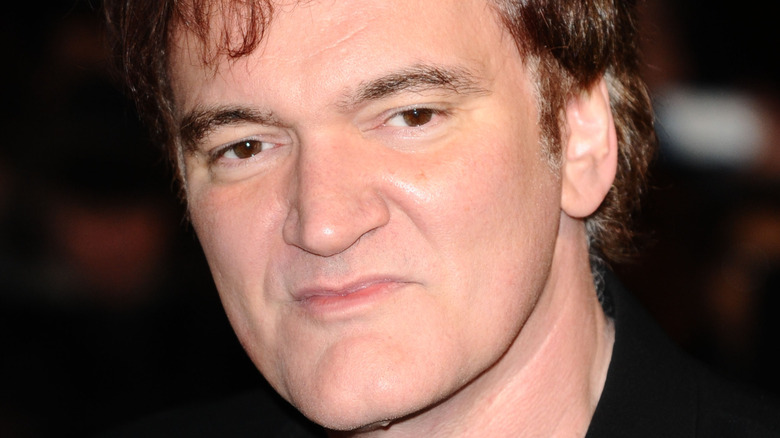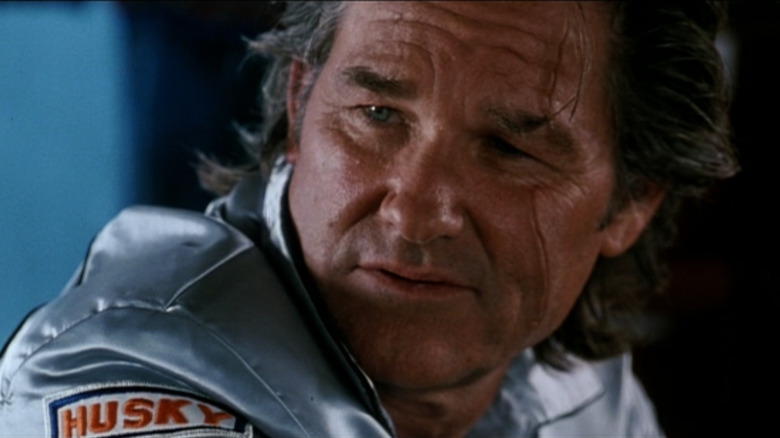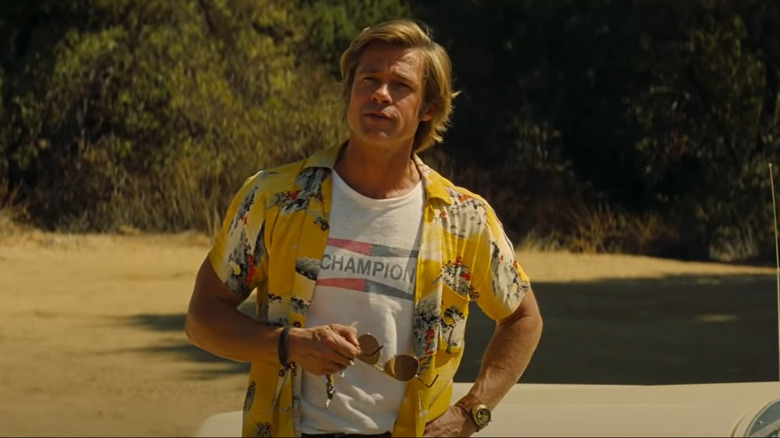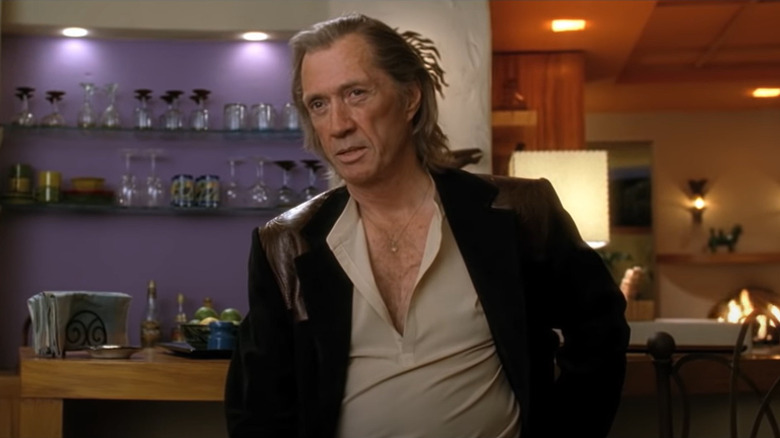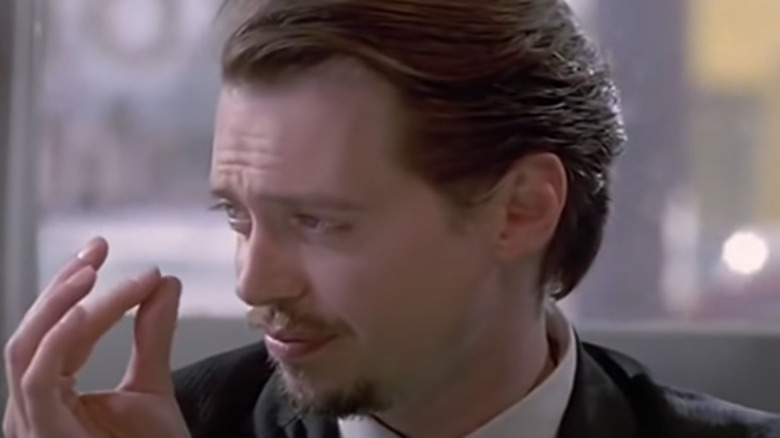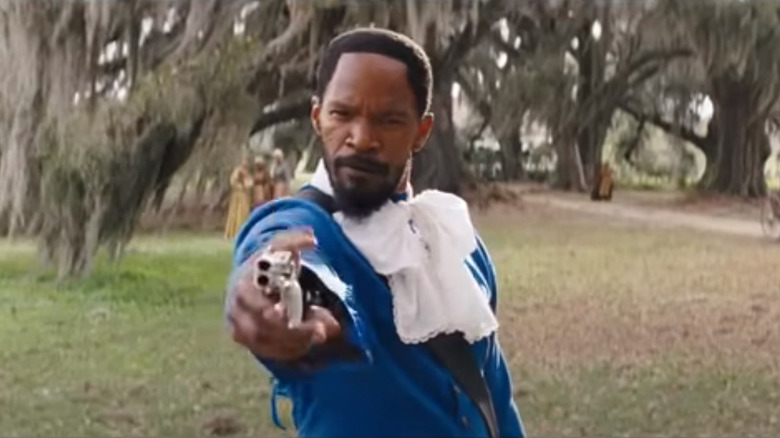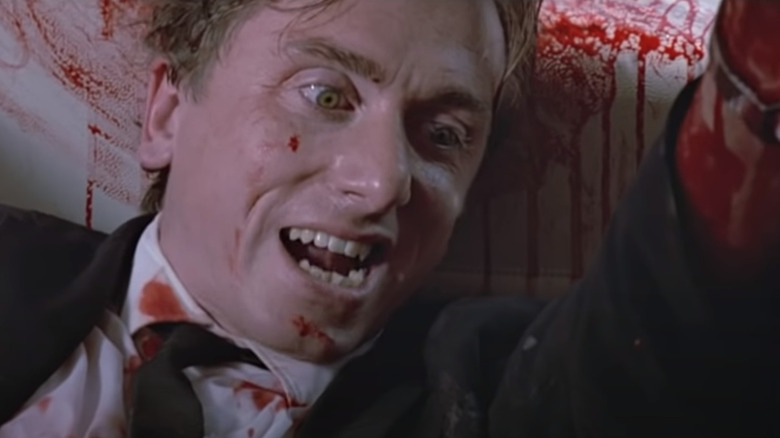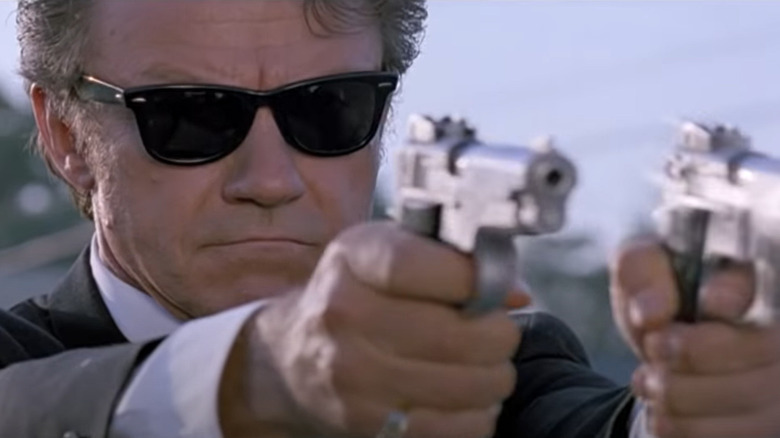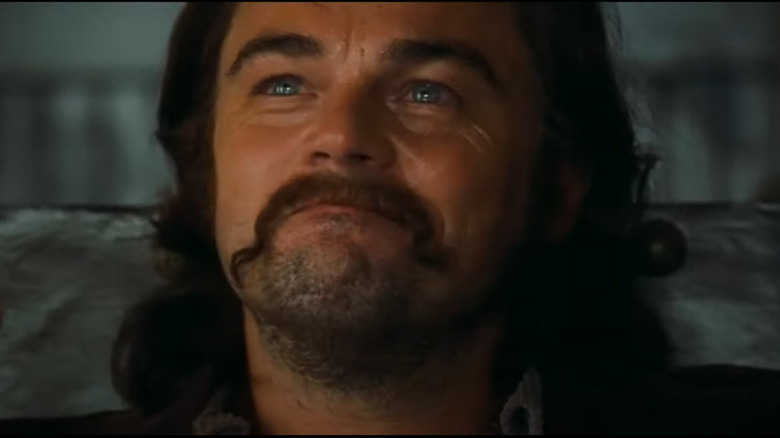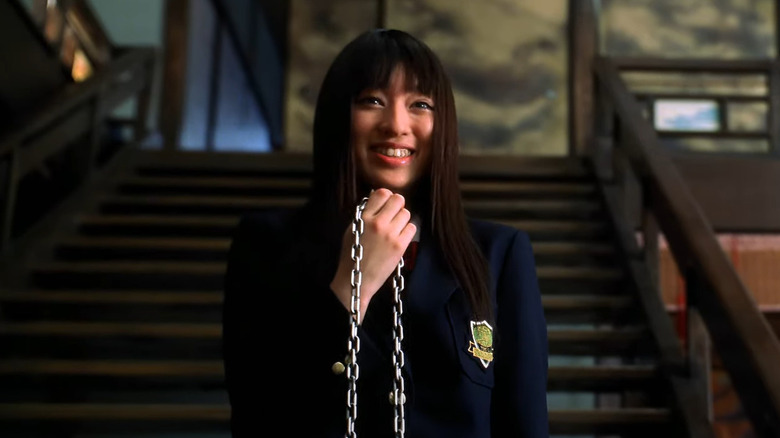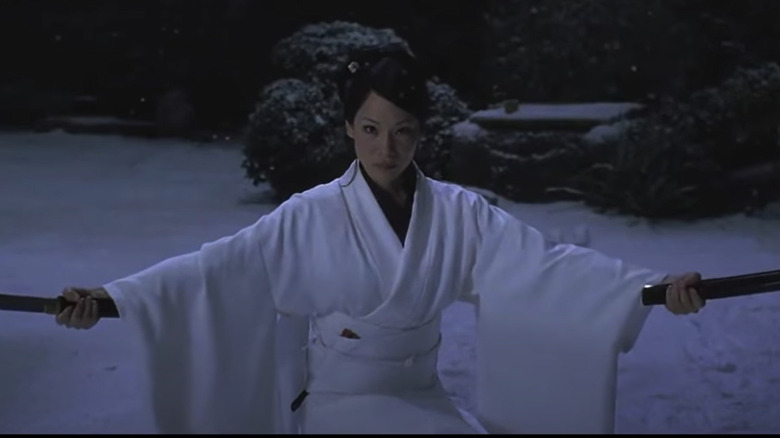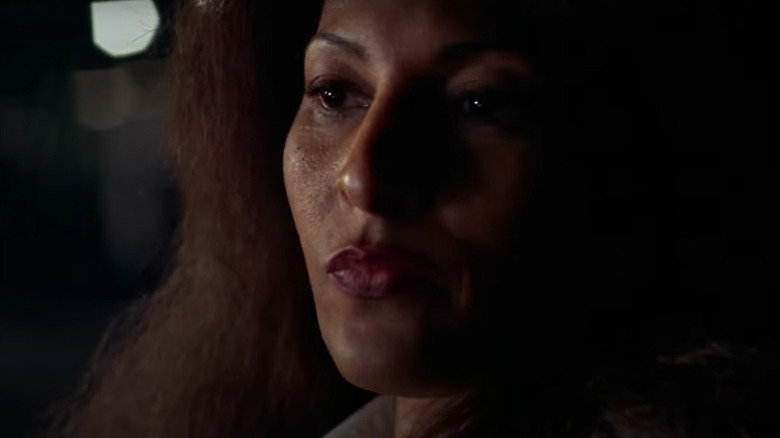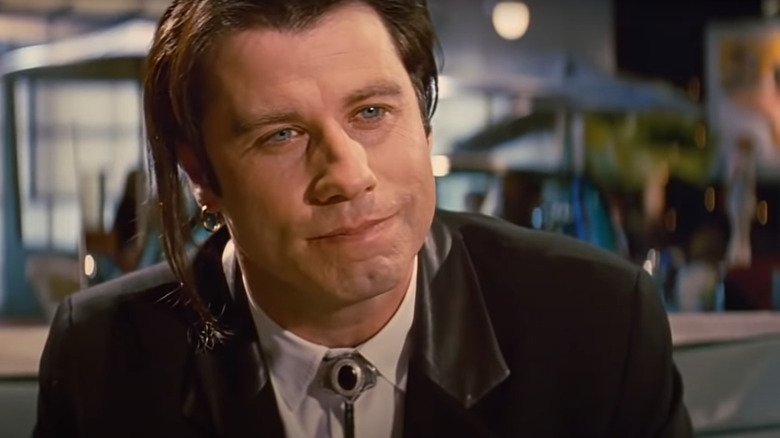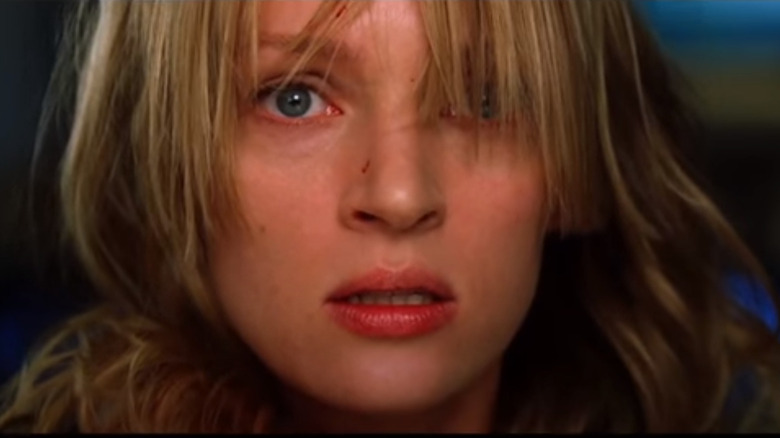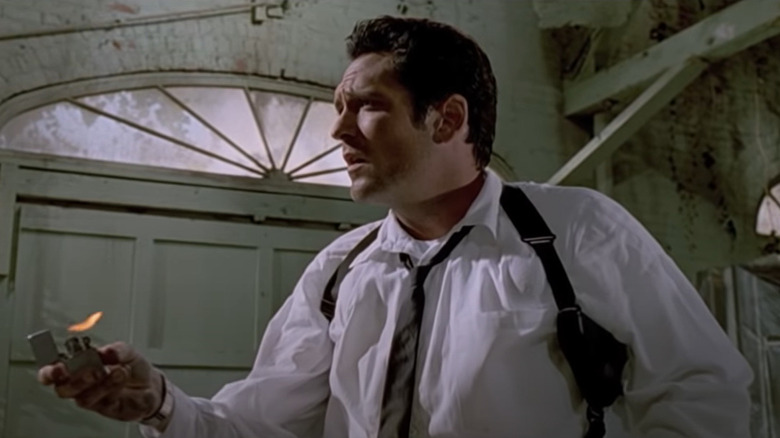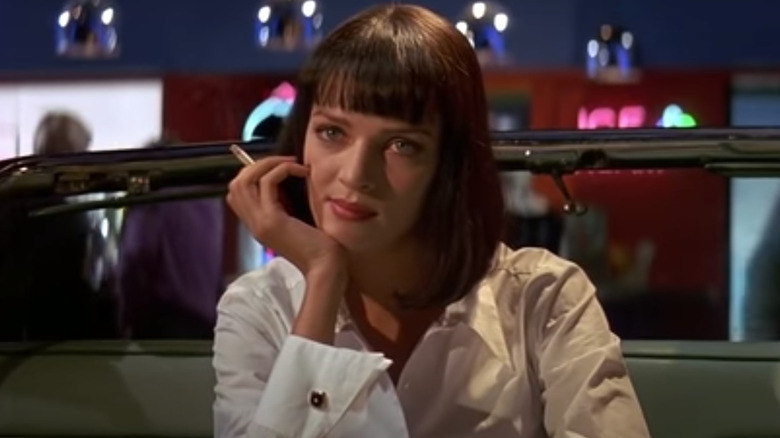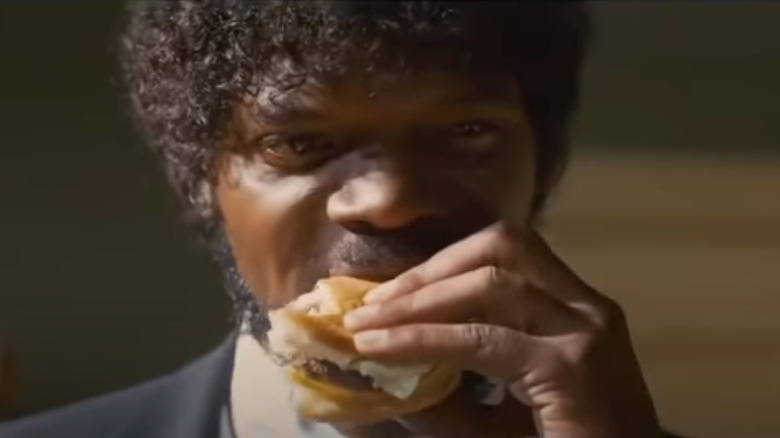Iconic Quentin Tarantino Characters Ranked
Despite his reputation for boundary-pushing violence, you can see a dozen brutal shootings and stabbings in a film and never wonder if you're watching a Quentin Tarantino movie. Countless other directors have made thousands of movies with equal or greater quantities of blood and guts, and they're not considered among the most influential filmmakers of their era.
In terms of surface-level elements, three factors distinguish Tarantino from the pack: gratuitous shots of women's feet, unforgettable characters, and razor-sharp dialogue. Ironically, it's really the talking scenes — not necessarily the sword fights or the shootouts — that make a Tarantino movie a Tarantino movie, but it's the characters saying that dialogue that we remember.
The director's feature-length debut, "Reservoir Dogs," is approaching its 30th anniversary, and Tarantino has made eight other movies — or nine, if "Kill Bill" counts as two — since the 1992 gangster shoot-'em up got Hollywood's attention. That's a lot of time and a lot of movies to load up with iconic characters. Shall we rank the most iconic of all? Let's go for it.
16. Stuntman Mike
"Death Proof" (2007) gets a raw deal. Released as part of the ill-fated attempt at double-feature revivalism titled "Grindhouse," its marketing failed spectacularly to entice the moviegoing public. Even many of the folks who did see it weren't entirely sure what to make of the underappreciated car crash-centric horror romp at first. It takes a severely gruesome tonal turn roughly 50 minutes in ... but ends on an surprise upbeat note.
Considering its generous indulgence in pop culture references, fairly lengthy conversational scenes, and abrupt shifts into graphic violence, "Death Proof" feels like the last film Tarantino made in his own signature style before he creatively moved on to historical revisionist epics. Also, it stars Kurt Russell — an action star from a previous generation playing a charming middle-aged guy who turns out to be a violent sociopath. Basically, Stuntman Mike is Bill (David Carradine) from "Kill Bill," except with a car instead of a sword and a whole lot less sanity.
15. Cliff Booth
Quentin Tarantino likes writing stunt people, from what we can tell. In "Death Proof," the villain is a stuntman, and one the heroes, Zoë Bell, is based on (and played by) real world stuntwoman Zoë Bell. But partly because "Death Proof" isn't as well known as "Once Upon A Time... in Hollywood" (2019), and partly because hardly anybody upstages Brad Pitt, Cliff Booth gets to be Tarantino's most iconic imaginary stuntman.
Cliff's eclectic fashion sense calls to mind one of Pitt's other signature roles — the suave, merciless cult leader Tyler Durden from "Fight Club" (1999). Despite Cliff's much more laid back demeanor and worldview, he messes up about as many people as Tyler — and even kills a few folks, including possibly his own wife. All we're saying is, if you ever see Brad Pitt wearing a Hawaiian shirt, find somewhere to hide, because that legendary Hollywood hunk is in berserker mode.
14. Bill
Seeing as how his name is right there in the title of "Kill Bill," it might surprise you to find apex assassin Bill placed comparatively low on our evaluation of quintessential Tarantino characters. Granted, he wields David Carradine's near-supernatural charisma and espouses an amusing, while inaccurate, monologue about Superman. However, Bill barely appears in "Kill Bill: Vol. 1" (2003). While he more than makes himself known in "Kill Bill: Vol. 2" (2004), he also competes for iconic status against fellow "Vol. 2" antagonists Elle Driver (Daryl Hannah) and Budd (Michael Madsen), both of whom would also appear on this list if it wasn't for this gosh-darned word count cap.
So while he doesn't make the top 10 of this particular list, nobody can deny Bill's capacity for disarming banter and stone-faced slaughter place him among the most compelling movie villains of the millennium thus far. Tarantino sounds interested in putting together "Kill Bill: Vol. 3," but let's get serious — Carradine passed away in 2009, and they can't make a "Kill Bill" without Bill, can they?
13. Mr. Pink
The guys in suits with colors for names in "Reservoir Dogs" all either die early in the film, or keep breathing long enough for the audience to learn their real names ... except for Mr. Pink (Steve Buscemi).
Mr. Pink thinks customary tipping is a grift, loves cigarettes, doesn't see a problem with the casual use of racial slurs, isn't too fond of the name "Mr. Pink," and that's just about all we ever find out about him. Even what happens to Mr. Pink at the end of "Reservoir Dogs" remains somewhat of a mystery. Even if he's simply gunned down by the police — as the film implies, but doesn't state outright — the fact that folks can imagine Mr. Pink's story continuing tells us he's a character who leaves an impression.
As Mr. Pink, Buscemi workshops an anxious, caustic ne'er-do-well persona that he perfects in The Coen Brothers' "Fargo" (1996), another essential '90s crime drama. Apparently, Buscemi also helped Tarantino flesh out Larry Dimmick, a.k.a. "Mr. White," by playing him in test footage during the film's developmental stage.
12. Django
Most of the imaginary individuals on this list are motivated primarily by greed. A few are motivated by revenge. A couple of others are driven by the sheer necessity for survival. Django (Jamie Foxx), on the other hand, is motivated by love.
In "Django Unchained," the titular hero embarks upon a quest to reunite with his wife, Broomhilda von Shaft (Kerry Washington). Since Django — a former slave in the pre-Civil War southern U.S. — must execute numerous racist white people on his journey, we suppose he's technically motivated by revenge as well. But the piles of dead slave traders are basically incidental to finding Broomhilda.
"Django Unchained" marks a major turning point for Tarantino. Before the 2012 neo-western, his cinematic observations about America focused on its popular culture. "Django..." casts its gaze on the nation itself.
Will Smith was famously close to playing the lead, but Foxx lends the character a certain understated steeliness it's hard to envision the typically quippy Smith bringing to the table. Django is quite like Neo from "The Matrix" in that respect.
11. Mr. Orange
Midway through "Reservoir Dogs," the secret allegiance of Mr. Orange (Tim Roth), a.k.a. Freddy Newendyke, swerves the film's trajectory in an almost unforeseeable direction.
In a vacuum, Freddy is not the most dynamic or charismatic participant in Joe Cabot's (Lawrence Tierney) doomed diamond heist. However, due to Roth's unmatched ability to pretend to slowly bleed out in blinding agony from a gunshot wound to the stomach for the better part of 90 minutes, and the fact that "Reservoir Dogs" doesn't really have a story without him, Mr. Orange surely belongs alongside Tarantino's most indelible creations.
Freddy also provides multiple "Dogs" highlights, including his pot dealing anecdote, in which he's miraculously ignored by four police officers as a drug sniffing German shepherd barks directly at him; and his helpful reminder to Officer Marvin Nash (Kirk Baltz) to stay cool because, in Freddy's words, "F*** YOU! I'M F***ING DYING OVER HERE! I'M F***ING DYING!"
10. Mr. White
Mr. White (Harvey Keitel), whose driver's license might describe him as "Lawrence Dimmick," arguably demonstrates more compassion than any other character in the oft-merciless world of "Reservoir Dogs." Paradoxically, his getaway scene paints him as one of the most effective killers of the bunch. He's not enthusiastic about taking lives, yet he appears to have significant experience with offin' folks.
Is Mr. White a "good guy" because he tries to help Mr. Orange, or a "bad guy" because he blows away at least two cops in cold blood? Mr. White gives us philosophical questions to think about.
He also anchors many of the film's most important scenes: the tone-establishing car ride to the hideout that follows the opening credits, the discussion and ensuing argument with Mr. Pink that rounds out the first act, and the standoff that concludes the brutal tale.
And if Mr. Pink had just let them take Mr. Orange to a hospital like Mr. White wanted, everything would have worked out much more favorably for everyone!
9. Rick Dalton
Describing Rick Dalton, an aging cowboy actor who struggles with faded relevancy, as a proxy for Tarantino's own arguable struggle with the advancing zeitgeist would be indulging in speculation. It's more responsible to explain "Once Upon A Time... In Hollywood" as Tarantino's answer to "BoJack Horseman." Both take place in slightly fantastical versions of Hollywood while addressing showbiz and the toll it takes on an individual's psyche, identity, and sense of self-worth. Plus, BoJack and Rick are both very funny guys, although they don't have everything in common — BoJack is a horse, and Rick is Leonardo DiCaprio.
We suppose other people might become Rick, depending on what comes of the talk regarding a "Once Upon A Time... In Hollywood" expanded universe. For now, we only know one version of Rick at the center of Tarantino's return to near-universal acclaim after "The Hateful Eight" (2015) garnered mixed reactions. If you think Rick's a washed-up lush whose best acting days are behind him, well sir, spoiler alert – maybe they ain't.
8. Gogo Yubari
Gogo Yubari (Chiaki Kuriyama) might not be as crucial to the story of "Kill Bill: Vol. 1" as other characters, but there's more to being iconic than spending the most minutes on screen.
Whereas the absence of Vernita Green (Vivica A. Fox) or Hattori Hanzo (Shin'ichi Chiba) would fundamentally alter "Vol. 1"; you could remove Gogo from "Kill Bill" entirely, and it wouldn't impact the plot at all. However, who looks cool on T-shirts? Who makes a badass action figure? Who almost kills The Bride (Uma Thurman) in the most ruthless fight scene in a film overflowing with ruthless fight scenes? It's Gogo.
While better recognized in Japan as a prolific television actor, American audiences know Kuriyama principally from "Kill Bill" and her brief but terrifying appearance in proto-"Hunger Games" gorefest "Battle Royale" (2000). We have no idea what Gogo's weapon — a small, bladed ball she swings on a chain — is called, but if we ever become assassins, we'd much rather fight with one of those than a Hanzo sword.
7. O-Ren Ishii
"Kill Bill" is certainly a catchy title, but a more accurate sobriquet for Tarantino's two-headed boy would be "Kill Bill, and also kill a handful of other instantly-classic villains."
Every former member of the Black Viper Assassination Squad is somebody's favorite; but not every one-time Bill protégé has their own personal army of malicious hipsters known as the Crazy 88, or a cool-as-hell theme song. They definitely don't all get to decapitate Boss Tanaka (Jun Kunimura) in the middle of a yakuza meeting. Those distinctions belong to O-Ren Ishii (Lucy Liu) exclusively.
Getting within sword-swinging distance of O-Ren requires dispatching dozens of subordinates — a condition that ultimately makes O-Ren both The Bride's most daunting adversary, and the source of one of the most epic movie fights of the millennium. We realize killing Bill requires a lot more emotional labor, but c'mon — "Kill Bill: Part 1" easily could have been called "Kill O-Ren."
6. Jackie Brown
Since "Pulp Fiction" (1994) inevitably inspired a legion of mediocre "Pulp Fiction" knockoffs, there was no need for Tarantino to parrot himself with "Jackie Brown" (1997). Plenty of other folks were already doing that job for him.
"Jackie Brown" doubles down on its predecessor's indebtedness to 1970s pop culture, but otherwise plays out as a much more grounded endeavor. Its criminals are overtly dishonorable and cruel. If "Reservoir Dogs" or "Pulp Fiction" gave you the impression Tarantino thinks gangers are suave, witty, relatable guys, this film will disabuse you of that notion.
The righteous, if ethically-neutral, center of "Jackie Brown" is the title character. Pam Grier arrived to the set with a truckload of pre-existing iconic status, but in a way, Jackie Brown stands out by not standing out. Throughout Tarantino's first three films, just about everyone is a hitman or a heroin dealer or a crime boss. By contrast, the working class heroes of "Jackie Brown" — Jackie and Max Cherry (Robert Forster) — talk and behave more-or-less the way we think of normal people talking and behaving. It's kind of hard to envision Jules Winnfield or Vincent Vega existing in the real world, but Jackie Brown seems entirely plausible.
5. Vincent Vega
With all due respect to Bruce Willis, his Butch Coolidge in "Pulp Fiction" could have been masterminded by a different director. Butch isn't too far removed from the meat-and-potatoes tough guy archetype Willis plays in plenty of other movies. Meanwhile, Vincent Vega (John Travolta) is a hitman and casual heroin user who works very hard to convince himself he isn't pining after his mythically protective crime boss's new wife (Uma Thurman). Vincent Vega could never exist anywhere outside of a Tarantino universe.
By 1994, Travolta's reputation as an actor to be taken seriously had been damaged by a slump in the '80s and one-too-many "Look Who's Talking" movies; but his turn in "Pulp Fiction" catapulted him back to major leading man status. He's tumbled back down the Hollywood totem pole since then, but at least he can always say his characters won two of the 20th century's most famous cinematic dance competitions: Jack Rabbit Slim's Twist Contest in this film, and the dance-off in "Saturday Night Fever" (1977).
4. The Bride
There's nothing special about the premise of the "Kill Bill" chronicle – stories about folks getting revenge on other folks for doing bad things have been around pretty much as long as stories have been a thing.
However, the cinematic endeavor in which a mysterious woman nicknamed "The Bride" (Uma Thurman) snaps out of a coma and proceeds to hunt down the former allies who attempted to kill her and successfully bumped off her husband and his family is one-of-a-kind — well, two of a kind, technically. Perhaps nothing of its ultra-violent nature approaches its maximalist execution.
Not all of the best "Kill Bill" scenes are fights, but most of them are, meaning The Bride is present and highly active for basically every important moment of the blood-soaked epic. Upon the occasions when the violence gives way to exchanges of verbal ideas, Thurman conjures righteous indignation, cold-blooded pragmatism, and sparse but effective displays of empathy.
Plus, as is likely the case for "Pulp Fiction," Thurman probably sold more than her share of tickets singlehandedly by looking like a complete badass on the poster.
3. Mr. Blonde
Perhaps the most completely evil villain in this cluster of moral ambiguity, Vic Vega — a.k.a. Mr. Blonde (Michael Madsen) — has the distinction of being parodied by Itchy and Scratchy, which expands the bejesus out of his scope of cultural visibility. As far as iconic status goes, a de facto "Simpsons" appearance grants him major bonus points.
Having recently ended a four-year stint in prison, Vic reenters society with a homicidal axe to grind. Off camera, Vic sets the events depicted in "Reservoir Dogs" in motion by slaughtering bystanders during the diamond robbery. On camera, his casually vicious removal of Officer Marvin Nash's ear and preparation to burn the unfortunate sap alive — all to the tune of "Stuck in the Middle With You" by Stealers Wheel — marks the dramatic apex of "Reservoir Dogs," and one of Tarantino's most memorable sequences.
According to The Hollywood Reporter, despite his conclusive fate in "Reservoir Dogs," Vic Vega almost returned for a prequel featuring himself on a caper alongside his equally-concluded brother Vincent Vega. Oddly enough, while Vic Vega tortures and almost murders a guy named Marvin, his brother successfully murders a different guy named Marvin by accidentally shooting him in the face. Perhaps the moral of Tarantino's earliest films is if your name is Marvin, stay away from anyone whose last name is Vega.
2. Mia Wallace
Coolness is kind of like abstract art. There is no steadfast definition of "cool," and there's no consensus agreement on what does and does not count as art. Nevertheless, we know art when we see it, and we know cool when we see it.
Unlike every other character on this list, Mia Wallace (Uma Thurman) doesn't kill anybody, nor is she directly involved in major illegal activities that "Pulp Fiction" makes us aware of. (Misdemeanor-level possession doesn't count.) Married to notorious crime lord Marsellus Wallace (Ving Rhames), the would-be star of "Fox Force Five" appears primarily interested in a good time.
Mia doesn't have to blow anyone's brains out or pull off an epic heist to achieve iconic status among Tarantino's characters or, for that matter, in '90s pop culture itself, which "Pulp Fiction" played a crucial role in defining. She only needs to order a five dollar milkshake, engage in casual conversation, and win a twist contest.
We know cool when we see if, and Mia Wallace has more pure, uncut coolness than she knows what to do with.
1. Jules Winnfield
Samuel L. Jackson had "Do The Right Thing" (1989), "Goodfellas" (1990), "Juice" (1992) and quite a few other roles under his belt before most folks had ever heard of Quentin Tarantino — so let's not give "Pulp Fiction" too much credit for making Jackson an insanely famous movie star.
However, his portrayal of hitman Jules Winnfield certainly resonates like a lightning in a bottle moment — the right actor found himself in the right role at the right moment in history.
Winnfield switches on a dime from charming to apocalyptic when confronting a room full of doomed slackers early in the movie, and virtually beams gravitas while talking down robbers Pumpkin (Tim Roth) and Honey Bunny (Amanda Plummer). Not only are these monologues from the beginning and end of the film amongst the most enduring and emulated segments in Tarantino's oeuvre, they're in the running for the best scenes of '90s films overall. It doesn't get more iconic than that.
